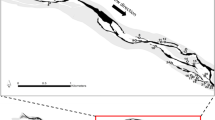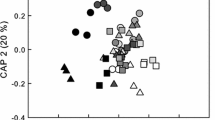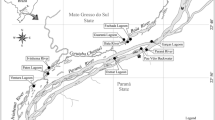Abstract
In tropical floodplain rivers, communities associated with structurally complex habitats are disassembled and reassembled as aquatic organisms repeatedly colonize new areas in response to gradual but continuous changes in water level. Thus, a neutral model reflecting random colonization and extinction dynamics may be sufficient to predict assemblage patterns at the scale of local habitat patches. If water level fluctuations and associated patch dynamics are sufficiently predictable, however, community assembly on habitat patches also may be influenced by species-specific responses to habitat features and/or species interactions. We experimentally manipulated structural complexity and proximity to source habitat (which influences colonization rate) of simulated rocky patches in the littoral zone of a tropical lowland river and demonstrate significant effects of both factors on species density of fishes and macroinvertebrates. Interspecific variation in vagility significantly affected assemblage response to habitat complexity. In a second experiment, created habitat patches were sampled over time intervals ranging from 1 day to 36 days to examine temporal dynamics of community assembly. A null-model test revealed that assemblage structure became increasingly non-random, concomitant with increasing species density, over time. Community dynamics in newly formed habitat patches appeared to be dominated by dispersal, whereas in older patches, abundances of individual species increasingly were influenced by habitat characteristics. These data suggest that species-specific responses to environmental variation resulted, in part, because of species interactions. We conclude that community assembly in shallow habitats of this tropical lowland river is influenced by physical habitat characteristics, the spatial distribution of habitat patches, and species interactions as habitats are saturated with individuals.



Similar content being viewed by others
References
Almany GR (2003) Priority effects in coral reef fish communities. Ecology 84:1920–1935
Amoros C, Bornette G (2002) Connectivity and biocomplexity in waterbodies of riverine floodplains. Freshwater Biol 47:761–776
Angermeier PL, Winston MR (1998) Local vs. regional influences on local diversity in stream fish communities of Virginia. Ecology 79:911–927
Arrington DA (2002) Evaluation of the relationship between habitat structure, community structure, and community assembly in a Neotropical blackwater river. In: Wildlife and Fisheries Sciences. Texas A & M University, College Station, TX, USA
Arrington DA, Winemiller KO (2003) Diel changeover in sand-beach fish assemblages in a Neotropical floodplain river. J Fish Biol 63:442–459
Bell G, Lechowicz MJ, Waterway MJ (2001) The scale of local adaptation in forest plants. In: Silvertown JJ, Antonovics J (eds) Integrating ecology and evolution in a spatial context. Blackwell, Oxford, pp 117–135
Bürnheim CM, Cox Fernandez C (2001) Low seasonal variation of fish assemblages in Amazonian rain forest streams. Ichthol Explor Freshwa 12:65–78
Clements FE (1949) Dynamics of vegetation. Hafner, New York
Cox-Fernandez C (1999) Detrended canonical correspondence analysis (DCCA) of electric fish assemblages in the Amazon. In: Val AL, Almeida-Val VMF (eds) Biology of tropical fishes. Instituto Nacional de Pesquisas Amazonicas, Manaus, pp 21–39
Ebeling AW, Hixon MA (1991) Tropical and temperate reef fishes: comparison of community structures. In: Sale PF (ed) The ecology of fishes on coral reefs. Academic, London, pp 509–563
Gotelli NJ (2000) Null model analysis of species co-occurrence patterns. Ecology 81:2606–2621
Gotelli NJ, Colwell RK (2001) Quantifying biodiversity: procedures and pitfalls in the measurement and comparison of species richness. Ecol Lett 4:379–391
Gotelli NJ, Entsminger GL (2001) EcoSim: null models software for ecology. In Version 7.0 edn. Acquired Intelligence Inc. & Kesey-Bear
Gotelli NJ, McCabe DJ (2002) Species co-occurrence: a meta-analysis of JM Diamond’s assembly rules model. Ecology 83:2091–2096
Goulding M, Carvalho ML, Ferreira EG (1988) Rio Negro: rich life in poor water. SPB Academic Publishing, The Hague
Grossman GD, Ratajczak RE Jr, Crawford M, Freeman MC (1998) Assemblage organization in stream fishes: effects of environmental variation and interspecific interactions. Ecol Monogr 68:395–420
Hixon MA, Beets JP (1993) Predation, prey refuges, and the structure of coral-reef fish assemblages. Ecol Monogr 63:77–101
Horwitz RJ (1978) Temporal variability patterns and the distributional patterns of stream fishes. Ecol Monogr 48:307–321
Hubbell SP (2001) The unified neutral theory of biodiversity and biogeography. Princeton University Press, Princeton
Hurtt GC, Pacala SW (1995) The consequences of recruitment limitations: reconciling chance, history and competitive differences between plants. J Theoret Biol 176:1–12
Jackson DA, Peres-Neto PR, Olden JD (2001) What controls who is where in freshwater fish communities—the roles of biotic, abiotic, and spatial factors. Can J Fish Aquat Sci 58:157–170
Junk WJ, Bayley PB, Sparks RE (1989) The flood pulse concept in river-floodplain systems. In: Dodge DP (ed) Proceedings of the international large rivers symposium vol 106. Canadian Special Publication Fisheries and Aquatic Sciences, pp 110–127
Layman CA, Winemiller KO (2004) Size-based responses of prey to piscivore exclusion in a species-rich neotropical river. Ecology 85:1311–1320
Lowe-McConnell RH (1964) The fishes of the Rupununi savanna district of British Guiana, Pt 1. Groupings of fish species and effects of the seasonal cycles on the fish. J Linnean Soc (Zoology) 45:103–144
Lowe-McConnell RH (1987) Ecological studies in tropical fish communities. Cambridge University Press, London
MacArthur RH (1970) Species packing and competitive equilibrium for many species. Theor Popul Biol 1:1–11
MacArthur RH, Wilson EO (1967) The theory of island biogeography. Princeton University Press, Princeton
Menge BA, Sutherland JP (1987) Community regulation: variation in disturbance, competition, and predation in relation to environmental stress and recruitment. Am Nat 130:730–757
Mérigoux S, Hugueny B, Ponton D, Statzner B, Vauchel P (1999) Predicting diversity of juvenile neotropical fish communities: patch dynamics versus habitat state in floodplain creeks. Oecologia 118:503–516
Oberdorff T, Hugueny B, Vigneron T (2001) Is assemblage variability related to environmental variability? An answer for riverine fish. Oikos 93:419–428
Olden JD, Jackson DA, Peres-Neto PR (2001) Spatial isolation and fish communities in drainage lakes. Oecologia 127:572–585
Petren K, Case TJ (1998) Habitat structure determines competition intensity and invasion success in gecko lizards. P Nat Acad Sci 95:11739–11744
Petry P, Bayley PB, Markle DF (2003) Relationships between fish assemblages, macrophytes and environmental gradients in the Amazon River floodplain. J Fish Biol 63:547–579
Poff NL, Allan JD (1995) Functional organization of stream fish assemblages in relation to hydrological variability. Ecology 76:606–627
Power ME (1984) Habitat quality and the distribution of algae-grazing catfish in a Panamanian stream. J Anim Ecol 53:357–374
Resh VH et al (1988) The role of disturbance in stream ecology. J North Am Benthol Soc 7:433–455
Robertson DR (1996) Interspecific competition controls abundance and habitat use of territorial Caribbean damselfishes. Ecology 77:885–899
Robinson CT, Tockner K, Ward JV (2002) The fauna of dynamic riverine landscapes. Freshwater Biol 47:661–677
Rodríguez MA, Lewis WM Jr (1997) Structure of fish assemblages along environmental gradients in floodplain lakes of the Orinoco River. Ecol Monogr 67:109–128
Ross ST, Matthews WJ, Echelle AA (1985) Persistence of stream fish assemblages: effects of environmental variation. Am Nat 126:26–40
Sale PF, Douglas WA (1984) Temporal variability in the community structure of fish on coral patch reefs and the relation of community structure to reef structure. Ecology 65:409–422
Schlosser IJ (1987) A conceptual framework for fish communities in small warmwater streams. In: Matthews WJ, Heins DC (eds) Community and evolutionary ecology of North American stream fishes. University of Oklahoma Press, Norman, pp 17–24
Schlosser IJ, Kallemeyn LW (2000) Spatial variation in fish assemblages across a beaver-influenced successional landscape. Ecology 81:1371–1382
Schoener TW (1988) Ecological interactions. In: Myers AA, Giller PS (eds) Analytical biogeography, an integrated approach to the study of animal and plant distributions. Chapman and Hall, London, pp 255–297
Shulman MJ, Ogden JC, Ebersole JP, McFarland WN, Miller SL, Wolf NG (1983) Priority effects in the recruitment of juvenile coral reef fishes. Ecology 64:1508–1513
Simberloff DS, Wilson EO (1969) Experimental zoogeography of islands: the colonization of empty islands. Ecology 50:278–296
Stone L, Roberts A (1990) The checkerboard score and species distributions. Oecologia 85:74–79
Stone L, Roberts A (1992) Competitive exclusion, or species aggregation? An aid in deciding. Oecologia 91:419–424
Syms C, Jones GP (2000) Disturbance, habitat structure, and the dynamics of a coral-reef fish community. Ecology 81:2714–2729
Taylor CM (1996) Abundance and distribution within a guild of benthic stream fishes: local processes and regional patterns. Freshwater Biol 36:385–396
Taylor CM, Warren ML Jr (2001) Dynamics in species composition of stream fish assemblages: environmental variability and nested subsets. Ecology 82:2320–2330
Tilman D (1994) Competition and biodiversity in spatially structured habitats. Ecology 75:2–16
Tonn WM, Magnuson JJ, Rask M, Toivonen J (1990) Intercontinental comparison of small-lake fish assemblages: the balance between local and regional processes. Am Nat 136:345–375
Townsend CR (1989) The patch dynamics concept of stream community ecology. J N Am Benthol Soc 8:36–50
Welcomme RL (1985) River fisheries. Food and Agriculture Organization Fisheries Technical Paper 262
Whittaker RH (1954) A consideration of climax theory: the climax as a population and pattern. Ecol Monogr 23:41–78
Willis SC, Winemiller KO, Lopez Fernandez H (2005) Habitat structural complexity and morphological diversity of fish assemblages in a Neotropical floodplain river. Oecologia 142(2):284–295
Wilson JB (1999) Assembly rules in plant communities. In: Weiher E, Keddy P (eds) Ecological assembly rules: perspectives, advances, retreats. Cambridge University Press, London, pp 130–164
Winemiller KO (1996) Dynamic diversity in fish assemblages of tropical rivers. In: Long-term studies of vertebrate communities. Academic, London
Acknowledgements
We thank D. Taphorn and the Museo de Ciencias Naturales, UNELLEZ for logistic and taxonomic assistance. Jonathan Armbruster graciously verified our loricariid identifications. We thank M. Hixon, T. Lacher, and B. Langerhans for constructive comments on the manuscript. We gratefully acknowledge Tour Apure and members of the Cinaruco River Fishing Lodge for providing logistic accommodations. A. Medina, Walt Arrington, T. Hibbitts, and M. Woods provided assistance with sampling. Specimens were collected under legal authority of permits issued by Venezuela’s Ministerio de Ambiente y Recursos Naturales Renovables. This research was supported by National Science Foundation grants DEB 0107456 and 0089834 and a U.S. Environmental Protection Agency STAR Fellowship.
Author information
Authors and Affiliations
Corresponding author
Additional information
Communicated by Dan Simberloff
Rights and permissions
About this article
Cite this article
Arrington, D.A., Winemiller, K.O. & Layman, C.A. Community assembly at the patch scale in a species rich tropical river. Oecologia 144, 157–167 (2005). https://doi.org/10.1007/s00442-005-0014-7
Received:
Accepted:
Published:
Issue Date:
DOI: https://doi.org/10.1007/s00442-005-0014-7




